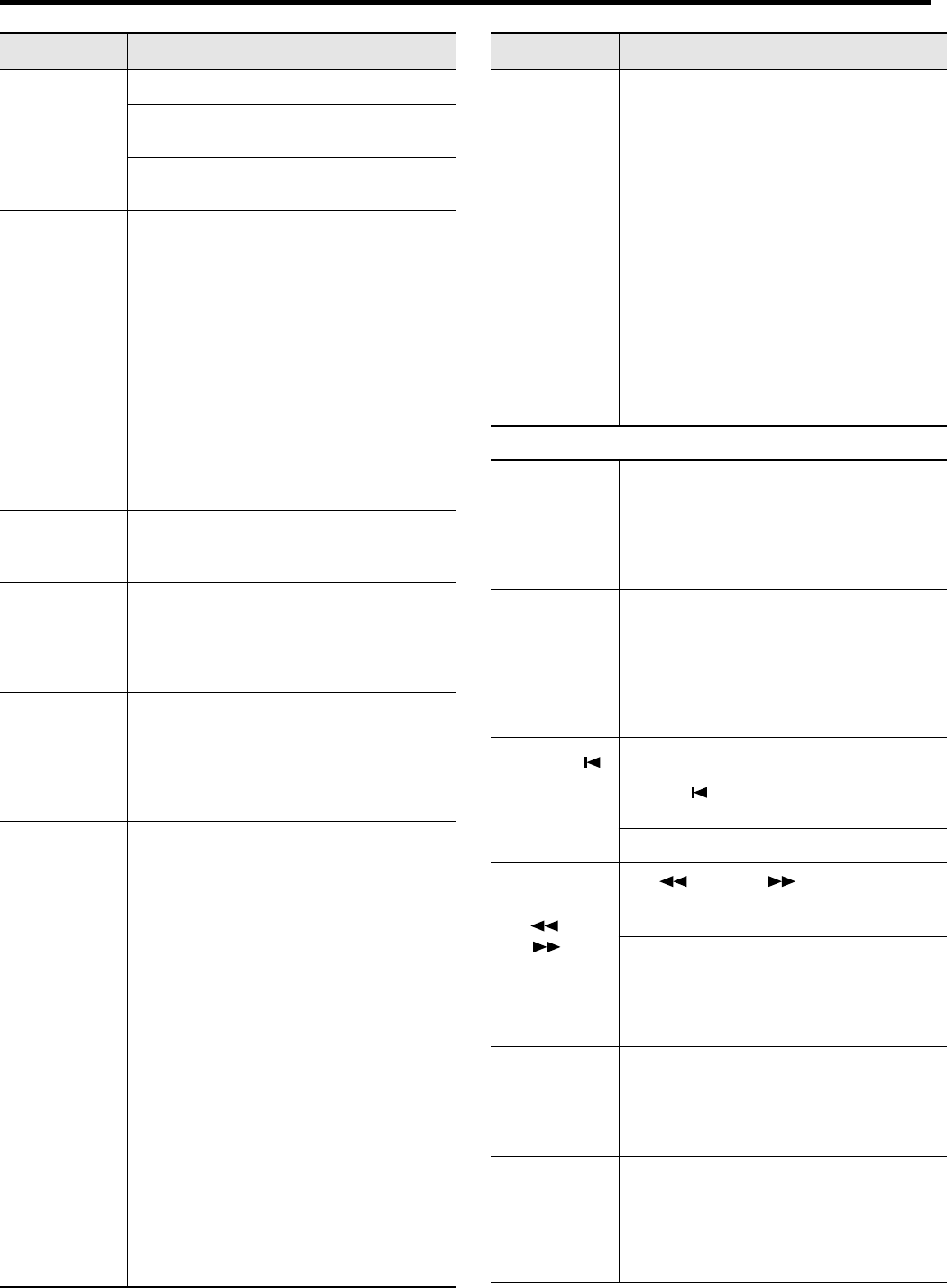
112
Troubleshooting
The tuning or
pitch of the
keyboard or song
is off
Have you set Transpose? (p. 69)
Are the settings for the “Temperament” (p. 89) and
“Stretch Tuning” (p. 88) correct?
Is the setting for the “Master Tuning” correct? (p.
89)
The wrong
instrument is
selected when
you press the
[Organ], [String],
or [Others] button
Tone buttons [Organ] [String] [Others] also
operate as buttons that select “Recommended
Tones.”
With the factory settings, connecting a
commercially-available CD-ROM drive to the
external memory connector and selecting a song
from a CD-ROM produced for the VIMA (VIMA
TUNES) will automatically cause sounds
appropriate for that song to be assigned to the
[Organ] [String], or [Others] Tone buttons, so that
you can select “recommended” tones by pressing
one of these buttons.
You can also make settings so that
“recommended” tones are not automatically
assigned.
Volume of
keyboard is too
low
Could the “Balance” setting be set all the way
toward “Accomp”? (p. 62)
The Tone has
changed
When a performance made along with a Music
Files tune has been recorded, recording the
performance to button [1/User] may make the
Tones for buttons [3/Left] and [4/Right] change as
well.
Reverberation still
audible even with
Reverb turned off
Since the HPi-6S’s piano sounds faithfully
reproduce the sense of spaciousness and
reverberation of an actual acoustic piano’s sound,
a certain amount of reverberation is still
perceptible, even with the reverb effect
deactivated.
In the upper
range, the sound
changes abruptly
beyond a certain
key
On an acoustic piano, notes in the upper one and
a half octaves of the keyboard continue to sound
until they decay naturally, regardless of the
damper pedal. There is a difference in the timbre
as well. Roland pianos faithfully simulate such
characteristics of the acoustic piano. On the HPi-
6S, the range that is unaffected by the damper
pedal will change depending on the Key
Transpose setting.
A High-pitched
whine is
produced
When listening through headphones:
Some of the more flamboyant and effervescent
piano tones feature an ample high-end
component, which may make the sound appear to
have metallic reverberation added. Since this
reverberation becomes particularly audible when
supplemented by heavy reverb, you may be able
to diminish the problem by reducing the amount of
reverb applied to the sound.
When listening through speakers:
Here, a different cause (such as resonance
produced by the HPi-6S) would be suspect. Consult
your Roland dealer or nearest Roland Service
Center.
Case
Cause/Remedy
The bass range
sounds odd, or
there is a
vibrating
resonance
When listening through speakers:
Playing at loud volumes may cause instruments
near the HPi-6S to resonate. Resonation can also
occur with fluorescent light tubes, glass doors, and
other objects. In particular, this problem occurs
more easily when the bass component is
increased, and when the sound is played at higher
volumes. Use the following measures to suppress
such resonance.
•Place speakers so they are 10–15 cm from walls
and other surfaces.
•Reduce the volume.
•Move the speakers away from any resonating
objects.
When listening through headphones:
Here, a different cause would be suspect. Consult
your Roland dealer or nearest Roland Service
Center.
Song doesn’t play back correctly
Song doesn’t play
back
Does the screen indicate message, like “OK to
delete Song?” (p. 42)
The internal songs cannot be played back while
recorded performance data remains in the HPi-
6S’s memory. Try playing back the song after
deleting the performance data.
Only the sound of
a particular
instrument in a
song does not
play
Is the indicator for the Track button extinguished?
(p. 60, p. 74, p. 94)
If the button indicator is out, the music on that track
is not heard. Press the track button so the indicator
is illuminated.
Or cancel the mute in the “16-track Sequencer”
screen.
Pressing the [
(Reset)] button
doesn’t return to
the beginning of
the song
Some music files may contain settings that stop
playing back at a point partway through the song.
Press the [
(
Reset)] button several times more to
return to the beginning of the tune.
Has a Marker placed in the song? (p. 67)
The [ (Fwd)]
and [ (Bwd)]
buttons don’t
work
The [ (Bwd)] and [ (Fwd)] buttons are
ignored while music files is being read in. Wait
until processing finishes.
If you attempt to play back performance data that
contains more data than the entire capacity of the
HPi-6S’s memory, you may find that operations
other than playback (such as rewind or fast
forward) become unavailable.
There is a slight
delay before
playback of a
song on USB
memory starts
There are two types of SMF music files: format 0
and format 1. If the song uses SMF format 1 data,
there will be a slight delay until playback starts.
Refer to the booklet that came with the music files
you’re using to determine the format type.
Lyrics are not
indicated
properly in the
display
With some music files, the lyrics cannot be
displayed correctly.
In the notation screen, some lyrics or notes could
extend beyond the edges of the screen, and not be
displayed.
Case
Cause/Remedy
HPi-6S-e.book 112 ページ 2007年11月19日 月曜日 午前10時36分


















